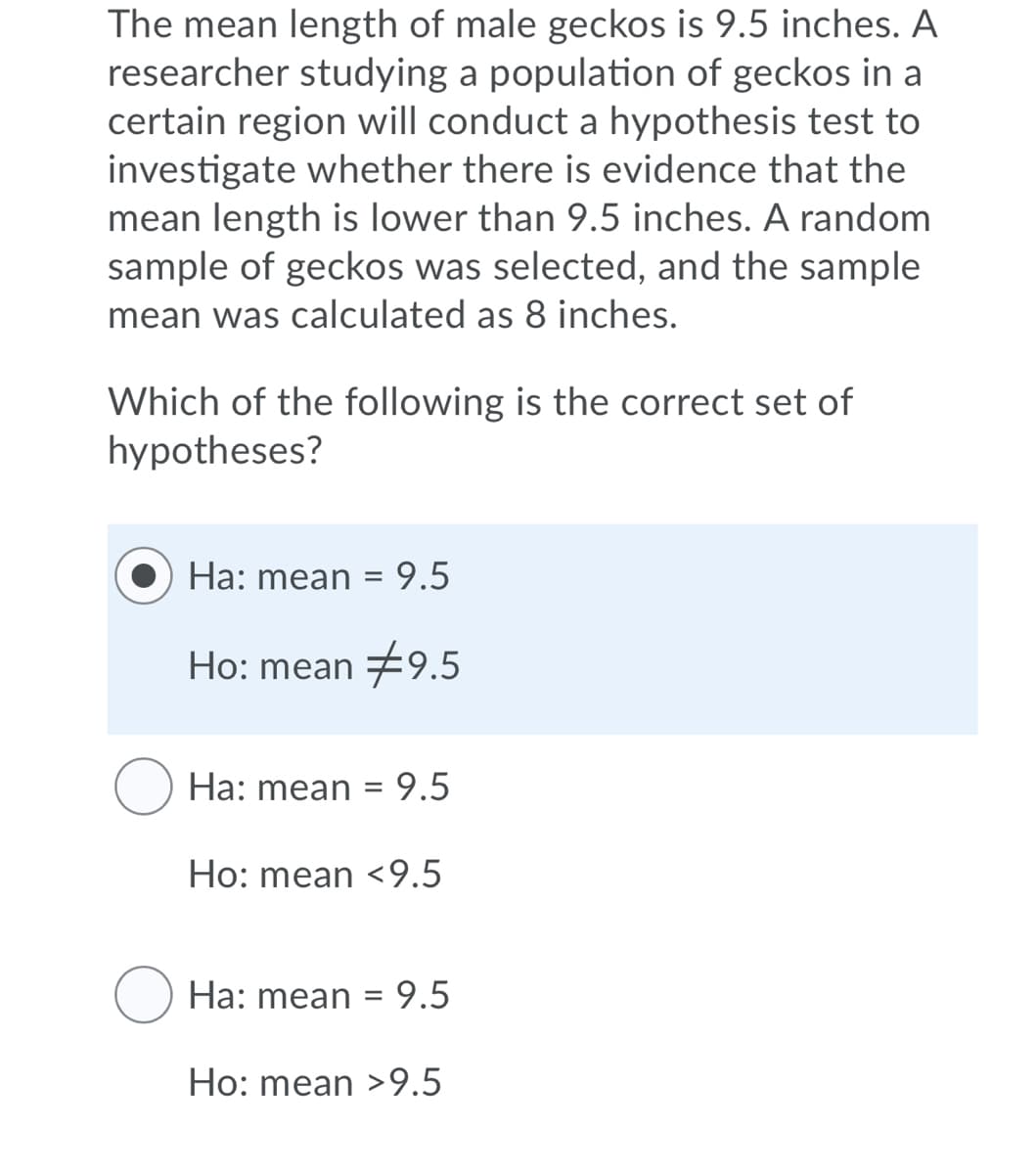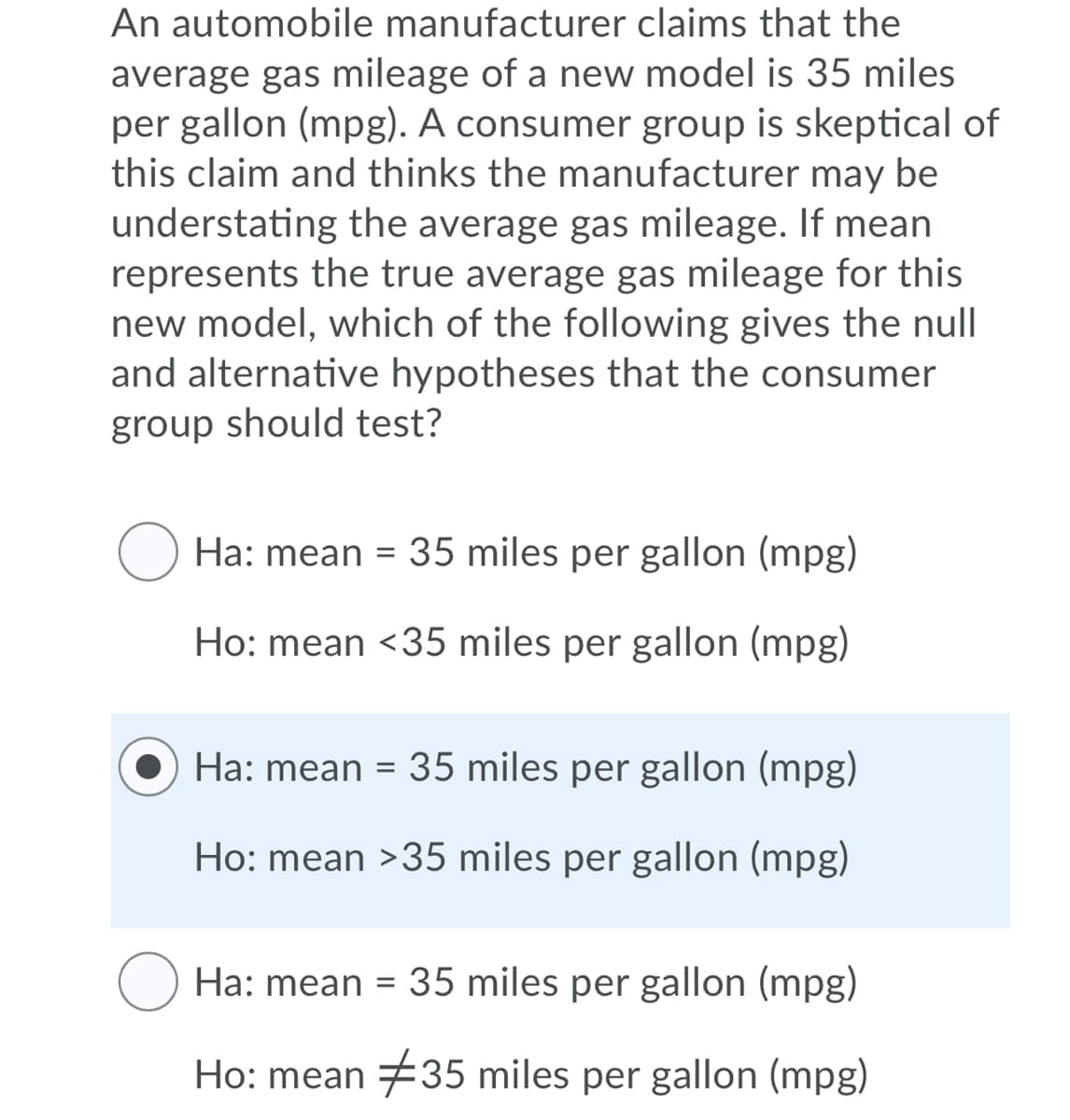The mean length of male geckos is 9.5 inches. A researcher studying a population of geckos in a certain region will conduct a hypothesis test to investigate whether there is evidence that the mean length is lower than 9.5 inches. A random sample of geckos was selected, and the sample mean was calculated as 8 inches. Which of the following is the correct set of hypotheses? Ha: mean = 9.5 Ho: mean #9.5 Ha: mean 9.5 %3D Ho: mean <9.5 Ha: mean = 9.5 Ho: mean >9.5
The mean length of male geckos is 9.5 inches. A researcher studying a population of geckos in a certain region will conduct a hypothesis test to investigate whether there is evidence that the mean length is lower than 9.5 inches. A random sample of geckos was selected, and the sample mean was calculated as 8 inches. Which of the following is the correct set of hypotheses? Ha: mean = 9.5 Ho: mean #9.5 Ha: mean 9.5 %3D Ho: mean <9.5 Ha: mean = 9.5 Ho: mean >9.5
Glencoe Algebra 1, Student Edition, 9780079039897, 0079039898, 2018
18th Edition
ISBN:9780079039897
Author:Carter
Publisher:Carter
Chapter10: Statistics
Section10.3: Measures Of Spread
Problem 1GP
Related questions
Topic Video
Question

Transcribed Image Text:The mean length of male geckos is 9.5 inches. A
researcher studying a population of geckos in a
certain region will conduct a hypothesis test to
investigate whether there is evidence that the
mean length is lower than 9.5 inches. A random
sample of geckos was selected, and the sample
mean was calculated as 8 inches.
Which of the following is the correct set of
hypotheses?
Ha: mean = 9.5
Ho: mean #9.5
Ha: mean = 9.5
Ho: mean <9.5
Ha: mean = 9.5
Ho: mean >9.5

Transcribed Image Text:An automobile manufacturer claims that the
average gas mileage of a new model is 35 miles
per gallon (mpg). A consumer group is skeptical of
this claim and thinks the manufacturer may be
understating the average gas mileage. If mean
represents the true average gas mileage for this
new model, which of the following gives the null
and alternative hypotheses that the consumer
group should test?
Ha: mean = 35 miles per gallon (mpg)
Ho: mean <35 miles per gallon (mpg)
O Ha: mean = 35 miles per gallon (mpg)
Ho: mean >35 miles per gallon (mpg)
O Ha: mean = 35 miles per gallon (mpg)
Ho: mean #35 miles per gallon (mpg)
Expert Solution
This question has been solved!
Explore an expertly crafted, step-by-step solution for a thorough understanding of key concepts.
This is a popular solution!
Trending now
This is a popular solution!
Step by step
Solved in 2 steps

Knowledge Booster
Learn more about
Need a deep-dive on the concept behind this application? Look no further. Learn more about this topic, statistics and related others by exploring similar questions and additional content below.Recommended textbooks for you

Glencoe Algebra 1, Student Edition, 9780079039897…
Algebra
ISBN:
9780079039897
Author:
Carter
Publisher:
McGraw Hill

Glencoe Algebra 1, Student Edition, 9780079039897…
Algebra
ISBN:
9780079039897
Author:
Carter
Publisher:
McGraw Hill